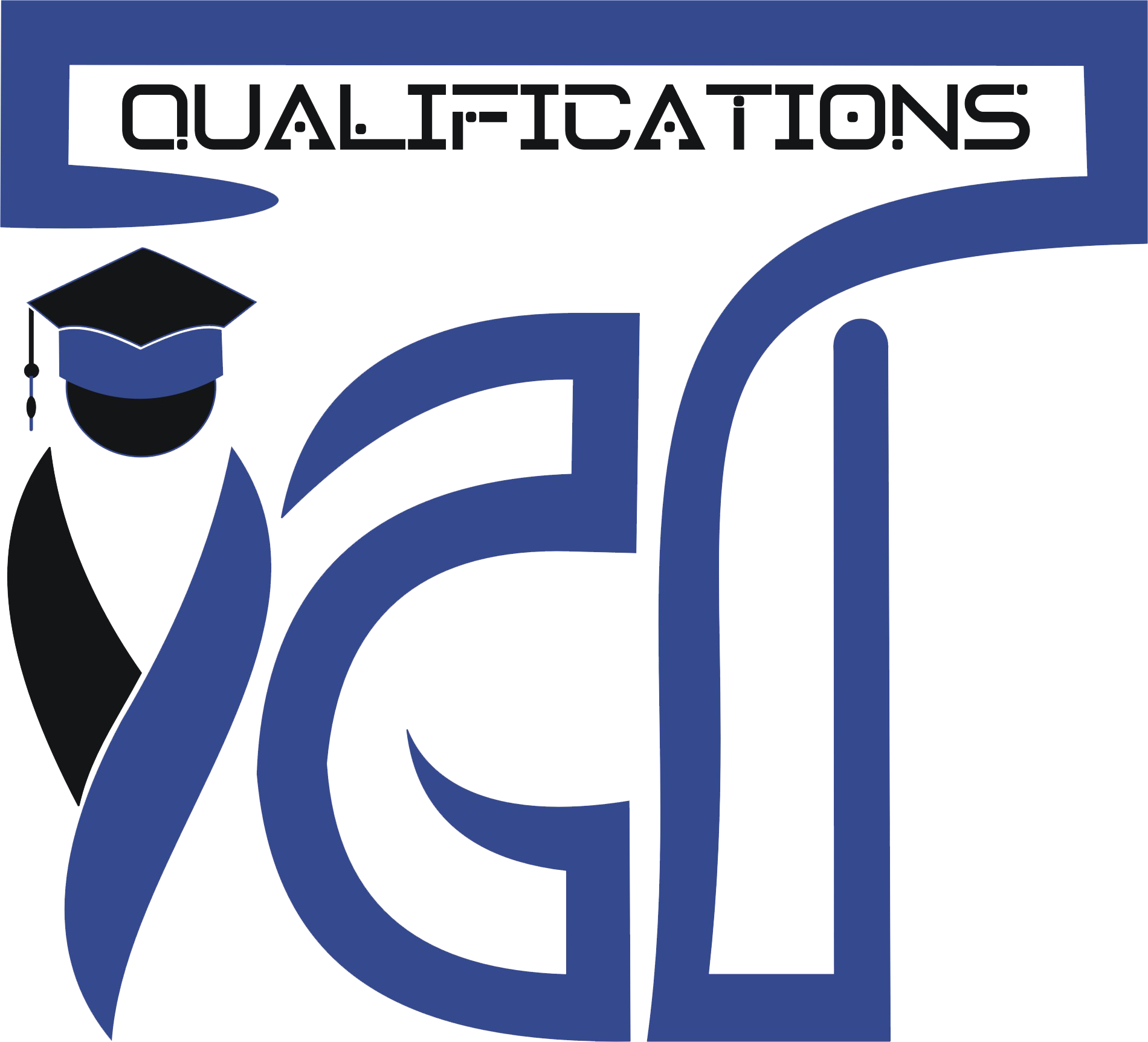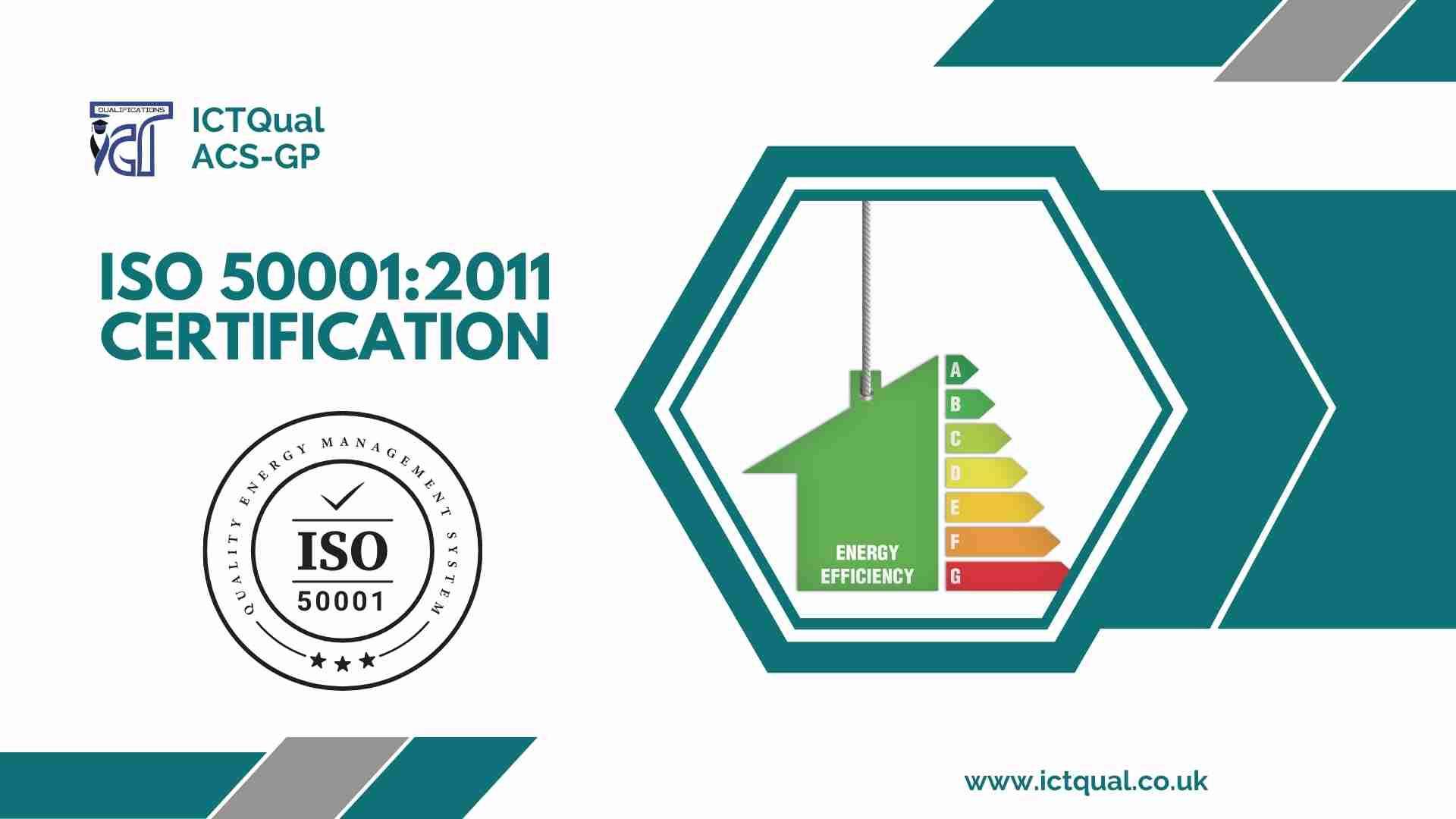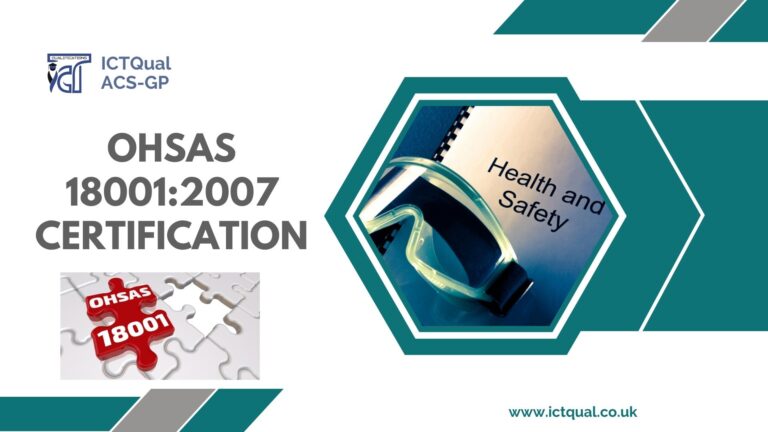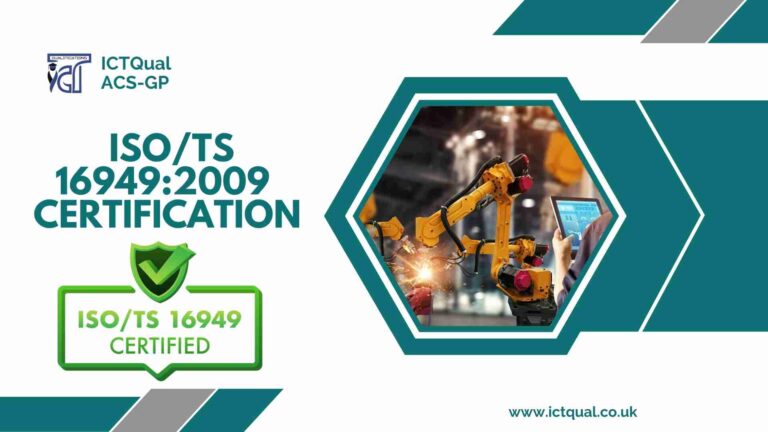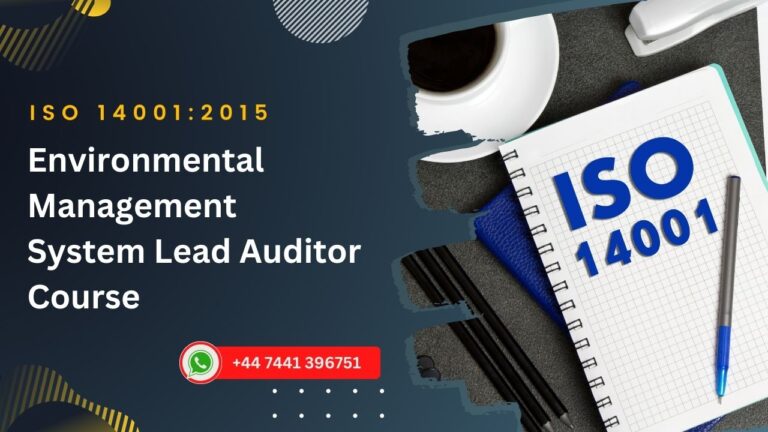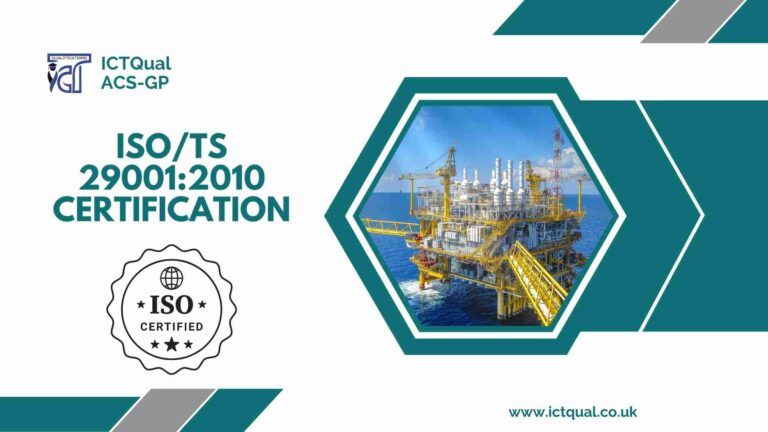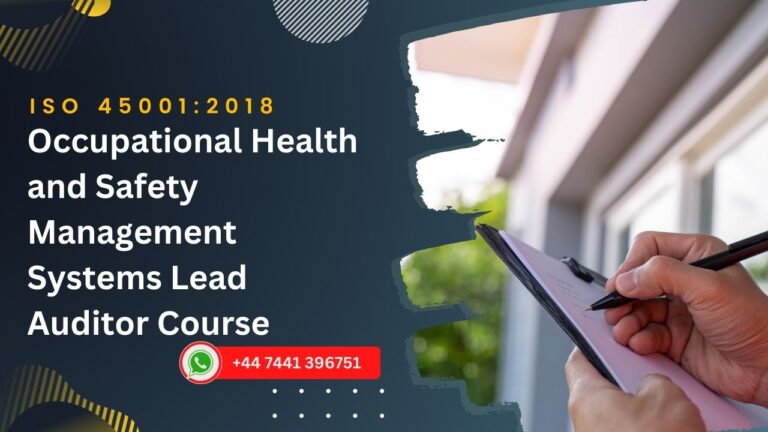Attention all businesses! Are you looking for a way to stand out in a crowded marketplace and enhance your reputation? Look no further than ISO 50001:2011 Certification! By implementing sustainable energy management practices and achieving ISO 50001:2011 Certification, you can improve customer loyalty, attract top talent, and gain a competitive advantage. Showcase your commitment to sustainability and energy management by prominently featuring your certification on your website, marketing materials, and social media channels. Become a thought leader in your industry by sharing your expertise and collaborating with other certified companies. Don’t miss out on the opportunity to establish yourself as a leader in your industry and attract customers who prioritize sustainability and social responsibility. Contact us to learn more about how ISO 50001:2011 Certification can enhance your company’s reputation and provide a competitive advantage.
ICTQual is Exclusive partner of ACS-GP and providing services for company registration with ISO in following ISO Standards
ISO 50001:2011 Certification and its Importance
ISO 50001:2011 Certification is a globally recognized standard that sets the framework for energy management systems (EnMS) for organizations. It provides a systematic approach to managing energy usage and reducing costs, while promoting environmental sustainability. Companies that achieve ISO 50001:2011 Certification demonstrate their commitment to sustainable energy management and contribute to reducing their carbon footprint.
The ISO 50001:2011 standard was developed by the International Organization for Standardization (ISO) to help companies address energy efficiency and sustainability challenges. This standard is based on the Plan-Do-Check-Act (PDCA) cycle, which provides a structured approach for implementing and maintaining an EnMS.
ISO 50001:2011 Certification is essential for company registration as it provides a competitive advantage and helps companies comply with regulatory requirements related to energy management. In today’s market, companies that can demonstrate their commitment to sustainable energy management are more likely to attract customers, partners, and investors who value environmental responsibility.
ISO 50001:2011 Certification can also help companies achieve cost savings through improved energy efficiency. By identifying areas of energy waste and optimizing energy consumption, companies can reduce their operating costs and enhance their financial performance.
In addition, ISO 50001:2011 Certification provides a framework for continuous improvement, enabling companies to monitor and measure their energy usage and identify opportunities for improvement. This helps companies to stay competitive in the market and adapt to changing environmental regulations and customer expectations.
Benefits of ISO 50001:2011 Certification for Companies
ISO 50001:2011 Certification is an internationally recognized standard that provides a framework for energy management systems (EnMS). It helps businesses to improve their energy performance, reduce costs, and enhance their environmental sustainability. In this article, we’ll discuss the key benefits of ISO 50001:2011 Certification for companies.
Improved Energy Efficiency
ISO 50001:2011 Certification enables businesses to identify and manage their energy usage effectively. It provides a systematic approach to improving energy performance and reducing energy waste. By implementing an EnMS, companies can optimize their energy consumption, reduce energy costs, and improve their energy efficiency.
Cost Savings
Implementing an EnMS can lead to significant cost savings for companies. By reducing energy consumption and improving energy efficiency, businesses can save money on energy bills, maintenance costs, and equipment replacement costs. The cost savings generated by ISO 50001:2011 Certification can provide a significant return on investment for companies.
Competitive Advantage
ISO 50001:2011 Certification demonstrates a company’s commitment to sustainable energy management. It can enhance a company’s reputation and provide a competitive advantage in the market. Customers are increasingly aware of environmental issues and are more likely to do business with companies that prioritize sustainability.
Regulatory Compliance
ISO 50001:2011 Certification can help companies to comply with regulatory requirements related to energy management. Many countries and regions have implemented regulations related to energy efficiency and emissions reduction. ISO 50001:2011 Certification provides a framework for companies to comply with these regulations and avoid penalties.
Environmental Sustainability
Implementing an EnMS can contribute to a company’s efforts to reduce its carbon footprint and promote environmental sustainability. By optimizing energy consumption and reducing energy waste, businesses can minimize their impact on the environment. ISO 50001:2011 Certification provides a roadmap for companies to achieve their sustainability goals.
ISO 50001:2011 Certification provides numerous benefits for companies seeking to improve their energy performance, reduce costs, and enhance their environmental sustainability. By implementing an EnMS and obtaining certification, businesses can improve their energy efficiency, save money, enhance their reputation, comply with regulations, and reduce their carbon footprint. These benefits provide a compelling case for companies to pursue ISO 50001:2011 Certification as part of their sustainability strategy.
ISO 50001:2011 Certification for Company Registration
If your company is looking to improve energy efficiency, reduce costs, and promote environmental sustainability, ISO 50001:2011 Certification is a valuable tool that can help you achieve those goals. In this article, we’ll provide a step-by-step guide to obtaining ISO 50001:2011 Certification for company registration.
Establish an Energy Management Team
The first step in obtaining ISO 50001:2011 Certification is to establish an energy management team. This team should be responsible for overseeing the development, implementation, and maintenance of the energy management system (EnMS). The team should consist of individuals from different departments within the company, including energy managers, facility managers, and other key stakeholders.
Conduct an Energy Review
The next step is to conduct an energy review. This involves identifying the company’s energy sources and usage and evaluating opportunities for improvement. The energy review should include an analysis of the company’s current energy usage, as well as an assessment of potential energy savings.
Develop an Energy Policy
Once the energy review is complete, the next step is to develop an energy policy. The energy policy should outline the company’s commitment to sustainable energy management and include specific goals for reducing energy consumption and improving energy efficiency. The energy policy should also include a plan for communicating the company’s energy management objectives to all employees.
Implement an EnMS
The fourth step is to implement an EnMS. This involves developing and implementing procedures and processes to manage energy usage effectively. The EnMS should include a system for monitoring and measuring energy usage, as well as a plan for identifying and addressing energy waste.
Monitor and Measure Performance
The fifth step is to monitor and measure energy performance. This involves regularly tracking energy usage and evaluating the effectiveness of the EnMS. By monitoring and measuring energy performance, companies can identify opportunities for improvement and take corrective action as necessary.
Obtain Certification
The final step is to obtain certification. Companies can engage a certification body to conduct an audit and provide certification for compliance with ISO 50001:2011. The certification process involves a review of the company’s energy management system and an assessment of its effectiveness in achieving energy savings and reducing energy waste.
Obtaining ISO 50001:2011 Certification for company registration is a process that involves establishing an energy management team, conducting an energy review, developing an energy policy, implementing an EnMS, monitoring and measuring performance, and obtaining certification. By following these steps, companies can successfully implement an EnMS and obtain ISO 50001:2011 Certification, demonstrating their commitment to sustainable energy management and achieving the benefits that come with it.
Implementing an Energy Management System (EnMS)
Implementing an Energy Management System (EnMS) can help companies reduce their energy consumption, lower costs, and contribute to environmental sustainability. However, the process can be complex and daunting, particularly for those who are new to the concept. Here is a step-by-step guide to help companies implement an EnMS effectively.
Establish an Energy Management Team
The first step in implementing an EnMS is to establish an Energy Management Team. This team should consist of individuals from various departments who will be responsible for developing, implementing, and maintaining the EnMS. The team should include an Energy Manager who will oversee the implementation process and ensure that the EnMS aligns with the company’s objectives.
Conduct an Energy Review
The next step is to conduct an energy review to identify the company’s energy sources and usage. The review should include an analysis of energy bills, energy audits, and a review of the company’s production processes. The energy review will help identify areas where energy usage can be optimized and will provide a baseline for monitoring energy performance.
Develop an Energy Policy
An energy policy is a statement of the company’s commitment to sustainable energy management. The policy should be developed with input from all stakeholders and should outline the company’s objectives, targets, and responsibilities for achieving sustainable energy management.
Establish an EnMS Framework
The EnMS framework should be developed based on the company’s energy policy and should include procedures and processes for managing energy usage effectively. The framework should identify the roles and responsibilities of the Energy Management Team and establish performance indicators for monitoring energy performance.
Implement EnMS Procedures and Processes
The next step is to implement the EnMS procedures and processes. This may involve training employees on energy management practices, developing energy-saving procedures, and implementing energy-efficient technologies. The Energy Management Team should ensure that the EnMS procedures and processes are communicated effectively throughout the company.
Monitor and Measure Energy Performance
To evaluate the effectiveness of the EnMS, energy performance should be monitored and measured regularly. This will involve setting performance indicators, collecting data, and analyzing the results. The Energy Management Team should use this data to identify areas where energy usage can be optimized and to implement corrective actions.
Continual Improvement
The EnMS should be reviewed regularly to ensure that it continues to align with the company’s objectives and to identify opportunities for improvement. Continual improvement may involve refining EnMS procedures and processes, implementing new technologies, or setting more ambitious energy targets.
Implementing an EnMS can be a complex process, but by following these steps, companies can ensure that they are managing their energy usage effectively. The key is to establish a framework that aligns with the company’s objectives, implement EnMS procedures and processes effectively, monitor and measure energy performance regularly, and strive for continual improvement. By doing so, companies can reduce their energy consumption, lower costs, and contribute to environmental sustainability.
How it Can Enhance Your Company’s Reputation
As businesses seek to differentiate themselves in a crowded marketplace, they must focus on ways to enhance their reputation and establish themselves as leaders in their industry. One way to achieve this is through the implementation of sustainable energy management practices and the attainment of ISO 50001:2011 Certification. This internationally recognized standard can provide companies with a competitive advantage and enhance their reputation in the marketplace.
Benefits of ISO 50001:2011 Certification for Competitive Advantage
- Increased Customer Loyalty: Consumers are becoming increasingly environmentally conscious, and they prefer to do business with companies that prioritize sustainability. ISO 50001:2011 Certification demonstrates a company’s commitment to sustainable energy management and can enhance customer loyalty.
- Improved Reputation: Companies that achieve ISO 50001:2011 Certification are viewed as leaders in their industry and are recognized for their commitment to sustainable energy management. This can improve a company’s reputation and enhance its credibility.
- Cost Savings: Implementing an energy management system (EnMS) can lead to significant cost savings through reduced energy consumption and improved efficiency. This can be a significant competitive advantage, particularly in industries with narrow profit margins.
- Enhanced Marketability: ISO 50001:2011 Certification can provide a company with a competitive advantage by enhancing its marketability. Customers, partners, and investors are increasingly looking for businesses that prioritize sustainability and social responsibility.
- Improved Employee Morale: Employees want to work for companies that are committed to sustainability and social responsibility. ISO 50001:2011 Certification can improve employee morale and attract top talent to the company.
Strategies for Leveraging ISO 50001:2011 Certification for Competitive Advantage
- Incorporate ISO 50001:2011 Certification into Marketing Materials: Companies should prominently feature their ISO 50001:2011 Certification on their website, marketing materials, and social media channels to showcase their commitment to sustainability and energy management.
- Engage in Thought Leadership: Companies can establish themselves as thought leaders in their industry by sharing their sustainability and energy management expertise through webinars, blog posts, and other thought leadership content.
- Collaborate with Other ISO 50001:2011 Certified Companies: Companies can collaborate with other ISO 50001:2011 certified companies to showcase their commitment to sustainability and energy management and establish themselves as industry leaders.
- Participate in Industry Awards: Companies can participate in industry awards related to sustainability and energy management to showcase their achievements and enhance their reputation.
ISO 50001:2011 Certification can provide a competitive advantage for companies seeking to establish themselves as leaders in their industry. By implementing an EnMS and achieving ISO 50001:2011 Certification, companies can enhance their reputation, improve customer loyalty, and attract top talent. To leverage ISO 50001:2011 Certification for competitive advantage, companies should incorporate it into their marketing materials, engage in thought leadership, collaborate with other certified companies, and participate in industry awards.
Conclusion
In conclusion, ISO 50001:2011 Certification is an internationally recognized standard that can provide companies with a competitive advantage and enhance their reputation in the marketplace. By implementing sustainable energy management practices and obtaining ISO 50001:2011 Certification, companies can improve customer loyalty, enhance their reputation, and attract top talent. Leveraging ISO 50001:2011 Certification for competitive advantage requires companies to incorporate it into their marketing materials, engage in thought leadership, collaborate with other certified companies, and participate in industry awards. Ultimately, ISO 50001:2011 Certification can help companies differentiate themselves in a crowded marketplace and establish themselves as leaders in their industry.
